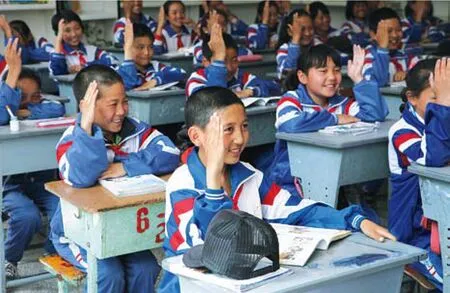Learning Another Language
2011-10-14ByWANGJUN
By WANG JUN
Learning Another Language
By WANG JUN
The first modern school in Tibet practices bilingual education to enhance students’ language-speaking skills
Tashi Tsehi is in the sixth grade at the Experimental Primary School of Qamdo Prefecture, Tibet Autonomous Region. Besides Tibetan, the native language of her ethnic group, the 14-year-old from a former herdsman’s family can now speak fl uentputonghua(mandarin Chinese).However, before she entered the school, she could not understand a single word of the new language.
“When I first began learning it, I knew little aboutputonghua. Then I asked my teachers to look up new words for me to learn in the dictionary. With their help, I quickly improved my pro fi ciency,” she toldBeijing Review.
Bilingual methodology
Established in 1951, the Experimental Primary School of Qamdo Prefecture is the first modern school in Tibet. Before that,there were only tutorial schools and temple schools for the rich or for monks.
According to Djanga, a school official,students are free to choose classes taught byputonghua- and Tibetan- speaking teachers. But the classes are all bilingual on certain occasions. For example, students of Tibetan-speaking classes use Chinesewritten textbooks for courses such as Chinese language, mathematics, English, science,music and sports, and the teachers speak both Tibetan andputonghuain class. While inputonghua-speaking classes, although the students don’t have Tibetan language courses, they can still learn the language by communicating with their classmates.
Deyang, a fi fth grader in a Tibetan class,said the students have courses on Tibetan,Chinese and English languages starting in the fi rst grade. “When we fi rst started school,some classmates had never learned Chinese,so Chinese was a little bit dif fi cult for them.But now, all the students can speak both Tibetan andputonghua,” she said.
Nine-year-old Tashi Reddin is the youngest student in the class. When taking a math test, he said, “All the test papers are written in Chinese, but this doesn’t make it any harder.”
According to Yonkin, the class advisor and mathematics teacher, all the 50 students of the class study both Tibetan and Chinese languages with the same devotion.
In the meantime, bilingual education can also help students improve their knowledge of the Tibetan language. According to Djanga, since some Tibetan students from urban families usually speakputonghua, their Tibetan language pro fi ciency is comparatively weak. Through bilingual education in the school, their Tibetan language level has been greatly improved, laying a solid foundation for furthering their language learning.

LANGUAGE LEARNERS: Pupils at the Experimental Primary School of Qamdo Prefecture in Tibet Autonomous Region during a class
To encourage students to study the Tibetan language, Djanga often suggests Tibetan parents speak their mother tongue at home and asks students to read more books in Tibetan.
Parental support
In recent years, as local people’s livelihoods have improved, many parents from the rural areas are eager for their children to receive higher levels of education.
“Our school is the first modern school in Tibet, so we are recognized to have better educational resources. Therefore many parents from the agricultural and pastoral areas have sent their children to study here,”Djanga said.
According to the school’s statistics, children from urban families used to account for 60 percent of its students, but since 2007, the situation has changed. Today, 55 percent of the students are from agricultural and pastoral families.
Many Tibetan parents have changed their minds about bilingual education, accepting and supporting the teaching method.
“In the past, many parents, especially those from rural areas, thought it was enough for their children to learn just Tibetan language so that they could recite Buddhist scriptures and calculate simple accounts,”Djanga said. “But now they are aware that their children must have a good command of written and spoken Chinese for future career development.”
To alleviate economic burdens on their families, some children from agricultural and pastoral families choose to work after graduating from middle school. Since they can speak both Tibetan and Chinese, they are very popular among employers.
Tashi Tsehi’s parents agree with Djanga.To ensure their three children receive better education, the couple decided to move from a village to Qamdo’s urban center nine years ago. Now the father works and the mother is a housewife. “My parents have realized the children must be literate. In the past they had no opportunity to go to school, but they want us to be well-educated even though they suffer hardships,” the girl said.
